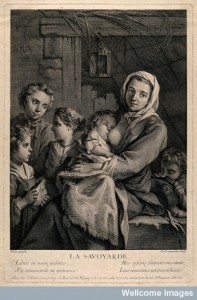By Lisa Smith (Regular Contributor)

A poor woman in a dingy attic, surrounded by her children, one of whom she is breast-feeding. Engraving by N. de Larmessin III after J. Pierre. Image Credit: Wellcome Library, London.
Whenever a hungry infant grandchild rooted for my mother’s breast, she would joke that “there isn’t any milk left in this old cow” and passed the child back to my sister for feeding. She clearly just wasn’t trying hard enough. After all, the Philosophical Transactions of the Royal Society printed cases of aged women who found themselves able to breastfeed their grandchildren…
In 1674, “A Person of Great Veracity” recounted two cases of breastfeeding grandmothers, one of which happened within his own family. Two months previously, the family had hired a nurse for their little girl, which entailed the nurse weaning her own son. But the boy kept “sucking the Breasts of his Grand-mother”, which caused “such a commotion in her, that abundance of milk run to her Breasts for a sufficient nourishment”.
To provide added authority, the author referred to a similar case from Vienna that had been described by Dutch physician Diemerbroeck. A poor woman gave birth to a healthy boy, but both the father and she died soon after. The sixty-six year old grandmother, Joanna Vuyltuyt, took in the child, but had no money to hire a nurse. She desperately attempted to feed the baby herself. “From that old woman’s strong imagination and vehement desire to give suck to this child”, she soon produced a good quantity of milk, and “all that saw it much wondered at” it.
Diemerbroeck and the “Person of Great Veracity” each provided a medical explanation for the cases: a physical reaction to stimulation or imagination and will. Both explanations made sense within the early modern medical world, depending on whether one saw the body as a machine filled with pumps and valves or a body that was intricately connected to one’s mind. There was a third reaction, however: wonder. This was, after all, no ordinary bodily behaviour.
Thomas Stack submitted a letter to the Phil. Trans. in 1739 about a sixty-eight year old grandmother “Who Gave Suck to Two of Her Grand-children”. Stack first heard of the case from “a gentleman of credit” who offered to take him to the breastfeeding granny of Tottenham Court Road (Elizabeth Brian) in London. The plan, this time, was to “discover some Fallacy in the Affair”; wonders were treated much more sceptically by 1739 than they had been sixty years earlier. Stack’s first impressions of the story’s plausibility were favorable: “Her Breasts were full, fair, and void of Wrinkles”, although the woman otherwise looked as old as might be expected for one who had spent the “last Half of her past life in Labour, troubles, and other concomitants of Poverty”.
Mrs Brian had not borne a child for twenty years, but had been breastfeeding her grandchildren for the last four years. Again, this was a case of financial and physical necessity. The mother had left the first infant with her mother and was “likely to be a considerable time absent” (presumably for employment). The little girl did not take to the forced weaning well, though, and was “froward for want of the Breast”. To keep the child quiet, the grandmother let her suckle and after several occasions of this, Mrs Brian’s son noticed that the child seemed to be swallowing something. The son “begg’d leave of his mother to try if she had not milk”. The son “drew Milk from that same Breast from which he had been wean’d above Twenty years”.[1] From that point on, Mrs Brian breastfed the child and was so successful that the daughter decided to have another baby, given that she had such a capable nurse.
Stack examined both girls, noting that they were healthy and sprightly. He also observed the youngest feed to make certain that the baby was truly drawing out milk. Stack did not offer any medical conclusions, but did determine that “the poor Woman seems perfectly honest and artless”. Mrs Brian, however, had an explanation: “She very religiously throws the whole upon a miracle”. And so it must have seemed.
Unusual cases, certainly, but not impossible. Modern medicine has found that milk can be produced by men and non-childbearing women, whether as a bodily malfunction (over-production of prolactin) or–most relevant in each of the early modern cases–as an adaptive measure to cope with maternal loss. In such cases, extreme psychological stress and stimulation of the nipple can result in the ability to breastfeed.[2] We might now have scientific studies, but that explanation sounds rather similar to the ones provided by Diemerbroeck and “A Person of Great Veracity” back in 1674.
In any case, despite my mother’s insistence, there could still be milk left in the old cow (sorry, Mom!)—but thank goodness it was never necessary.
[1] Early modern people were much less troubled by breast-feeding, even for adults. Very ill people might be breast-fed, while squirting breast-milk directly into the eye was often used for eye problems.
[2] Sobrinho, Luis Gonçalves. “Prolactin, Psychological Stress and Environment in Humans: Adaptation and Maladaption”. Pituitary 6 (2003): 35-39.
